Sri Lanka is an island in the Indian Ocean. Formerly known as Ceylon, this nation is renowned for its breathtaking natural scenery, mouth-watering cuisine, tropical beaches and excellent surfing.
In our team, the country is one of our favorites. That’s why we decided to share our experiences with surfers and non-surfers alike so that you too can make the most of your trip.
Organised in three sections. We will start by giving you general advice that applies to the whole country before going into more detail on the particularities of each coast (West and East).
General Tips For A Surf Trip To Sri Lanka
Relevant and useful information for the whole country.
the Surf in Sri Lanka
Sri Lanka is a popular travel destination because of its approachable waves and long-period swells.
Due to its high latitude in the Indian Ocean, the waves rarely exceed 7 feet, yet they are pretty reliable.
It is a year-round surfing hotspot. From November to April, the West coast will have optimal conditions; then from May to October, the East coast will shine. Essentially from a northern hemisphere person’s perspective, to have the best surf, head to the West coast of Sri Lanka when it’s cold and to the East coast during warmer months.
The surfing spots are all situated in the south of the Island, a few hours away from the main airport (Bandaranaike International Airport).
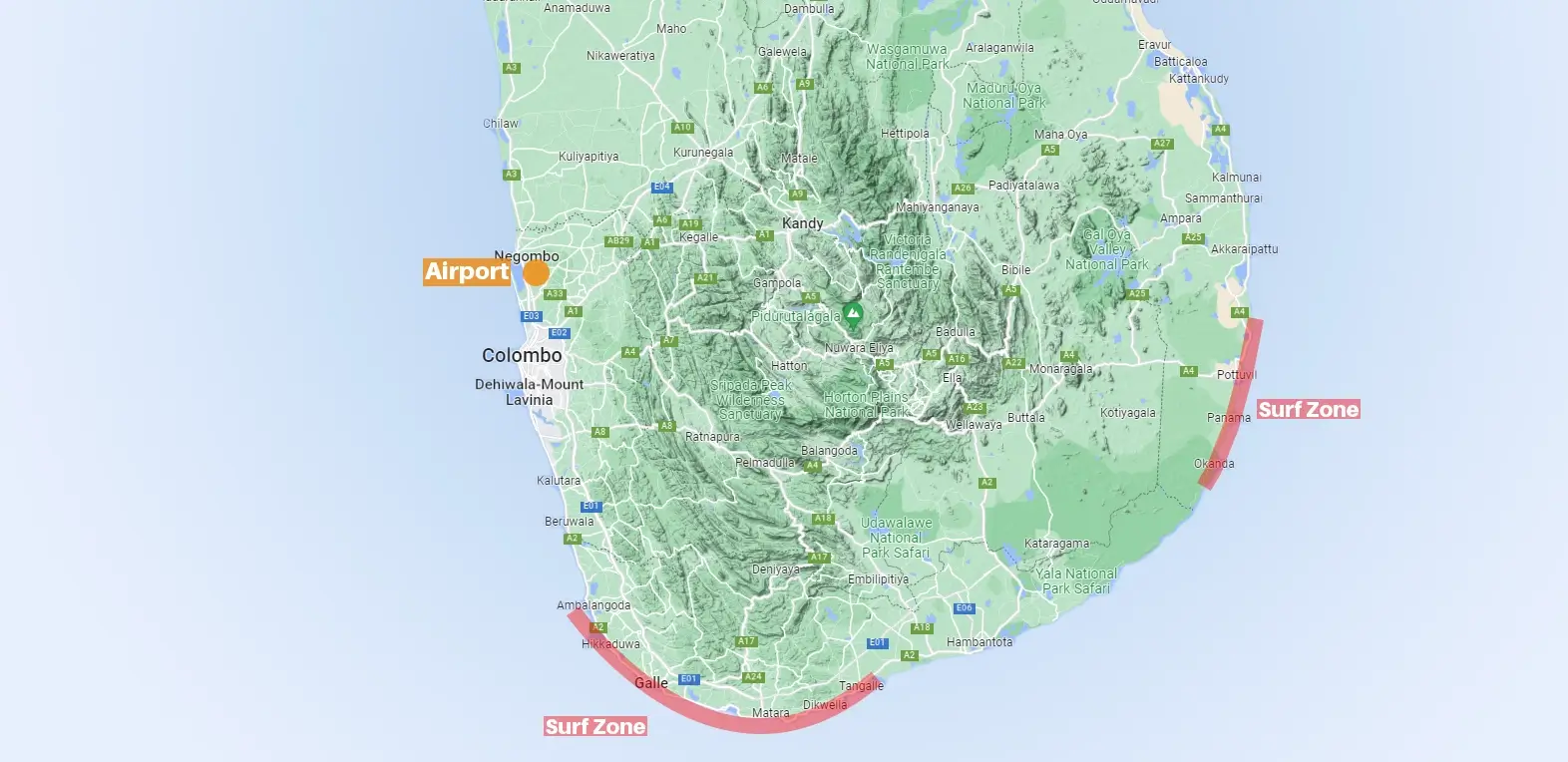
Covid situation and crysis in Sri lanka
As of January 2023, Sri Lanka has made itself readily accessible to foreign tourists. There is no requirement to present certificates of vaccination/testing for COVID-19.
Note that PCR tests are available near the coast in case you need to take one there, for instance, to travel back to your own country. Tests can be realized in Weligama, Matara, and Pottuvil. Without traveling to Colombo.
You should also be aware that Sri Lanka is currently going through a significant economic and political crisis, even though you probably won’t notice it in tourist areas.
how to change money in sri Lanka
Travelers may not be aware of this, but you should bring cash to Sri Lanka in contrast to most other nations.
Due to a significant difference between the official and unofficial rates of change, businesses favor foreign currencies. You may likely see advertisements in restaurants offering free side dishes if you pay with foreign currencies. Jewelry shops are notorious for offering informed tourists and locals such exchange rates.
The difference between the two rates in January 2022 was a massive 25%.
Sim Cards
You can obtain a SIM card at the airport from any of the leading mobile service providers. You will find vendors just near the arrival area’s exit.
Dialog appears to be the most reliable carrier in Sri Lanka (the biggest operator).
Remember to ask the vendor to text you your new phone number once the setup is complete.
Booking a hotel
It’s typically better to avoid making hotel reservations online.
Negotiating directly with the owner or management will get you better deals unless you are late. You could also be able to snag the perfect room in a hotel without an online presence. The pricing becomes better the longer you stay.
Be cautious where you choose to stay because the major road that hugs the coast can be noisy, and tourist bars do not have decibel restrictions.
Partying in Sri Lanka
Every day throughout the appropriate season, a party is organized in a different bar in Hikkaduwa, Midigama, and Arugam Bay. Find out where the next one is by asking around. Arrack and Lion beers will undoubtedly be the most popular beverages. Only specialized liquor stores outside of bars can sell alcohol.

Tips for a surfing trip On Sri Lanka’s west coast
What you need to know before going surfing in Sri Lanka’s southwest.
generalities
weather and surf forecasting
The weather is fantastic; occasionally, it may rain for less than an hour at sunset, but for the most part, the sky will be blue from sunrise to sunset.
Both the air and the ocean will be around 28 °C (82.4 °F). Morning and late afternoon sessions are often the cleanest, as the wind tends to pick up in the middle of the day.
For a surf forecast for the next three days, we suggest visiting Windguru. It is more accurate than other tools in Ceylon.
Waves of South West Ceylon
On Sri Lanka’s west coast, surfers can catch a variety of waves. A-frames, point breaks, and beach breaks are all present. Both as lefts and rights.
Waves are not often huge but are very consistent. An average day would be 4 ft (1.2m). Most of them are mellow rather than hollow. Still, you will be able to find your dose of beatings in some spots when a swell fills in.
How to get there

There are four ways to travel to the southwest of Sri Lanka. By taxi, train, bus, or self-driving vehicles.
By renting a car / taking a taxi
We suggest these alternatives if you have a longboard, SUP, or a huge board bag. You can get a taxi or rent a car directly from the airport. The “first” spots on the coast would be in Hikkaduwa. The town can be reached from the airport in about two and a half hours.
Nevertheless, the most affordable car rental options are available outside the airport. You can find several automobile rental services online with a fast search. For most of them, a brief bargain will significantly reduce online prices.
And If you choose to take a cab, you could save some money by sharing the cost. Numerous, very active Facebook groups are devoted to it. To get a better deal, we also advise you to hail a taxi outside Bandaranaike International Airport (a 100 meters walk). To avoid any tourist surcharges, you can also use the app “Pick Me,” which is comparable to uber.
By public transportation
To go to the southwest (Hikkaduwa, Midigama, Mirissa, etc.) by public transport, you must first travel to Colombo.
From the airport to Colombo
The direct bus service between the airport and Colombo has been discontinued as of January 2022 for an unknown length of time. But, alternatives exist.
It should take you a little bit more than one hour to get to the city center. You should not have any issues bringing a reasonably-sized surf bag on these transportation methods.
From Colombo to the southwest
Taking the train can be a cheap and fun way to travel in Sri Lanka.
For this, head to Maradana Station or Colombo Fort Station to board a train to the southwest. You may check the train schedule by selecting the station on Google Maps or by visiting this page. You will be able to choose between two classes, second and third classes, tickets are pretty inexpensive. First-class tickets must be reserved well before the travel and won’t be available. Due to the slight price difference, we advise using the second-class option since the wagon will have more space to store your surfboard.
Quick tips: The luggage compartment above the seats is a handy place to store surfboards. When traveling south, try to sit in the right row so you can have a view of the sea. And just so you know, there will be a more extended stop in Galle if you choose to take the train further south. The train will change tracks.
Pettah Bus station (near the Colombo fort) or Colombo Central Bus Stand is where you may get a bus to the southwest of Sri Lanka. Never be afraid to ask a local where the bus to your destination is located. You should give the bus that uses the toll road priority, it will be quicker. The ticket cost varies based on where you are going and is typically paid during the trip.
A 6“2 board bag or less will fit in the bus’s trunk. You can also put it next to you as an alternative (a second ticket could be needed).
Like trains, buses are a part of the Sri Lankan travel experience. You will be able to speak with a lot of curious locals while listening to loud Hindi music on a bus racing on the road.
How to reach the surf And move around
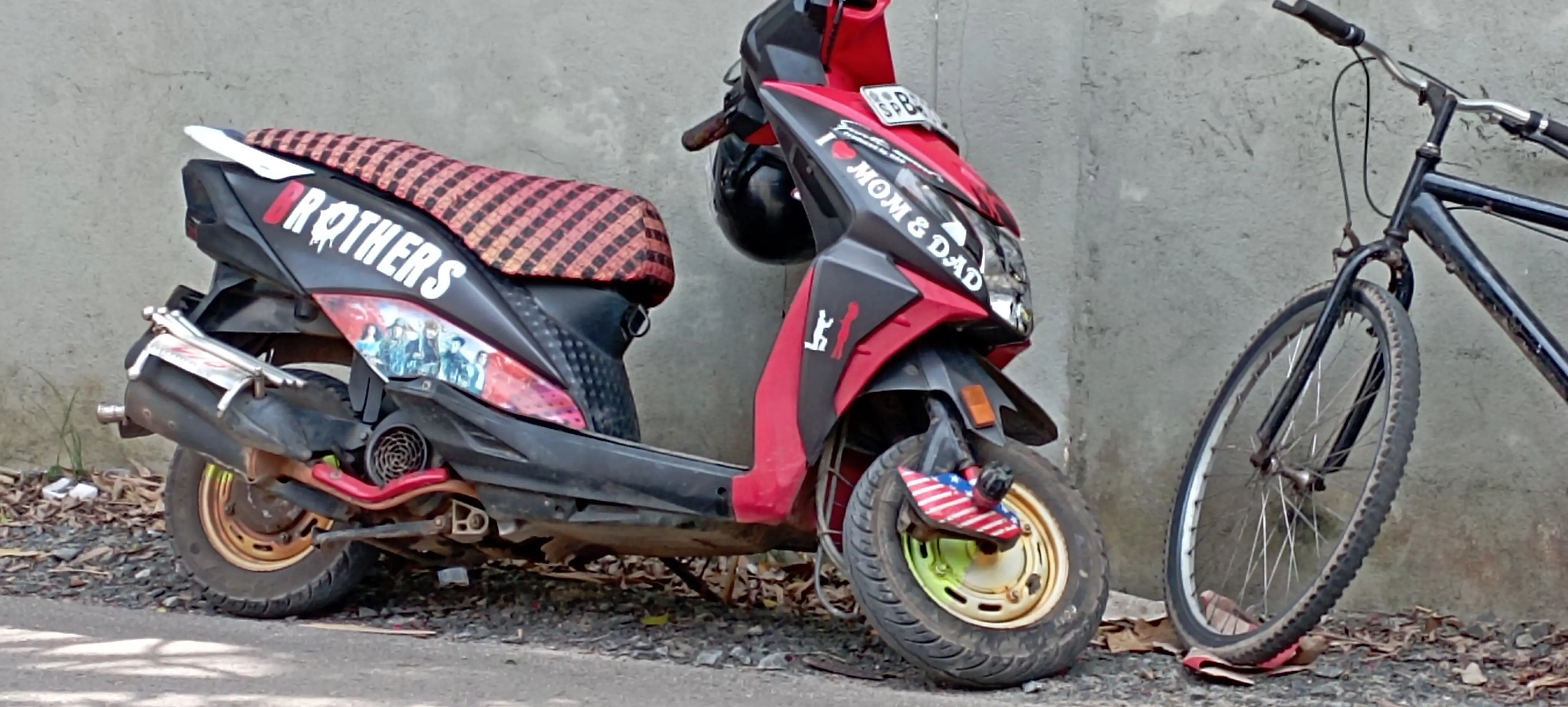
As mentioned, transportation along the coast is readily available by train, bus, or tuk-tuk.
There are trains and buses along the entire coast, which stop in most villages. Just be aware if you have a surfboard, local buses that have already left won’t stop for you. They do not want to wait for people to enter and exit since they are most of the time crowded and paid by the course.
Tuk-tuks can happily transport you and your equipment anywhere you desire.
However, obtaining your own vehicle is ideal to freely move around with your surfboard. So a personal Tuk-tuk or a moped/scooter is the favored form of transportation for surfers in the southwest.
A temporary license, which can be obtained in Colombo from the Automobile Association of Ceylon, is required to legally drive them in Sri Lanka. If the renter is not a surfer, bringing roof straps for your surfboard could be helpful.
If you decide to rent a scooter/moped or motorcycle in Sri Lanka, you must know that scooter surf racks are now prohibited. In some places, it may be tolerated, but the police may stop you and issue a fine. You can avoid that by doing the following:
- Place your surfboard in a bag, then drive while wearing the bag around your shoulder / neck (Pro Tip: protect the scooter from scratches made by the bag by putting tape on it)
- create a DIY soft rack with bungee cords purchased from nearby stores (attach it to the front plate and the back of your scooter)
Be aware that you must hold an international driver license to drive both a Tuk-Tuk and a Scooter in Sri Lanka. And be cautious on the road, people here do not drive like in western countries. Signals are optional and priority is given to the biggest vehicle. Try being predictive, if you are not feeling it, just don’t do it.
Surfing equipment in West Sri lanka
On the island, you can buy a surfboard. However, options are limited, and prices are likely to be on par with or more than in your home country. Because importing boards is expensive and the nation lacks a shaping industry.
Renting or bringing a surfboard to Sri Lanka
If you are only surfing for a few days, we recommend you rent a board in Sri Lanka. It will be less of a hassle than bringing your board. Just know that you won’t have access to many choices, and a lot of the boards are badly beaten due to the reasons explained above.
However, if you plan to surf for more than a few days. We recommend you bring your own equipment and all your gear in double. Like surfboards, surf accessories in Sri Lanka are rare and expensive, even wax…
We’ve got you covered here, we have a great selection of Leashes, Fins, and Traction Pads that we deliver worldwide, and yes, we ship to Sri Lanka!
the surf breaks on the west Side of the island
Most of the spots are between Hikkaduwa and Tangalle. In between, you will find Midigama. A small village that could be designated as the central hub for surfers on this coast of Sri Lanka.
By exploring the shoreline you will be able to find many uncrowded surf spots with a lot of variety, i.e., A-frame, beach breaks, point breaks, etc…
While we won’t go into detail about all the surfing spots here, we did make an effort to create a fully interactive Google Maps that lists most of them!
Sri Lanka surf spot map: Each blue point represents a different spot. The orange one represents places we judged nice to base yourself to go surf around. The swell generally comes from the southwest, so breaks after Matara tend to be smaller and less consistent.
The most well-known surfing spot on Sri Lanka’s west coast are:
- Hikkaduwa’s Main Point, a reef break with both lefts and rights
- Rams, a strong and competitive right that might be Sri Lanka’s equivalent of Bingin (Bali)
- Mirissa Main Spot, a picturesque right-hand point
- Weligama, a beach break favored by surf schools and beginners
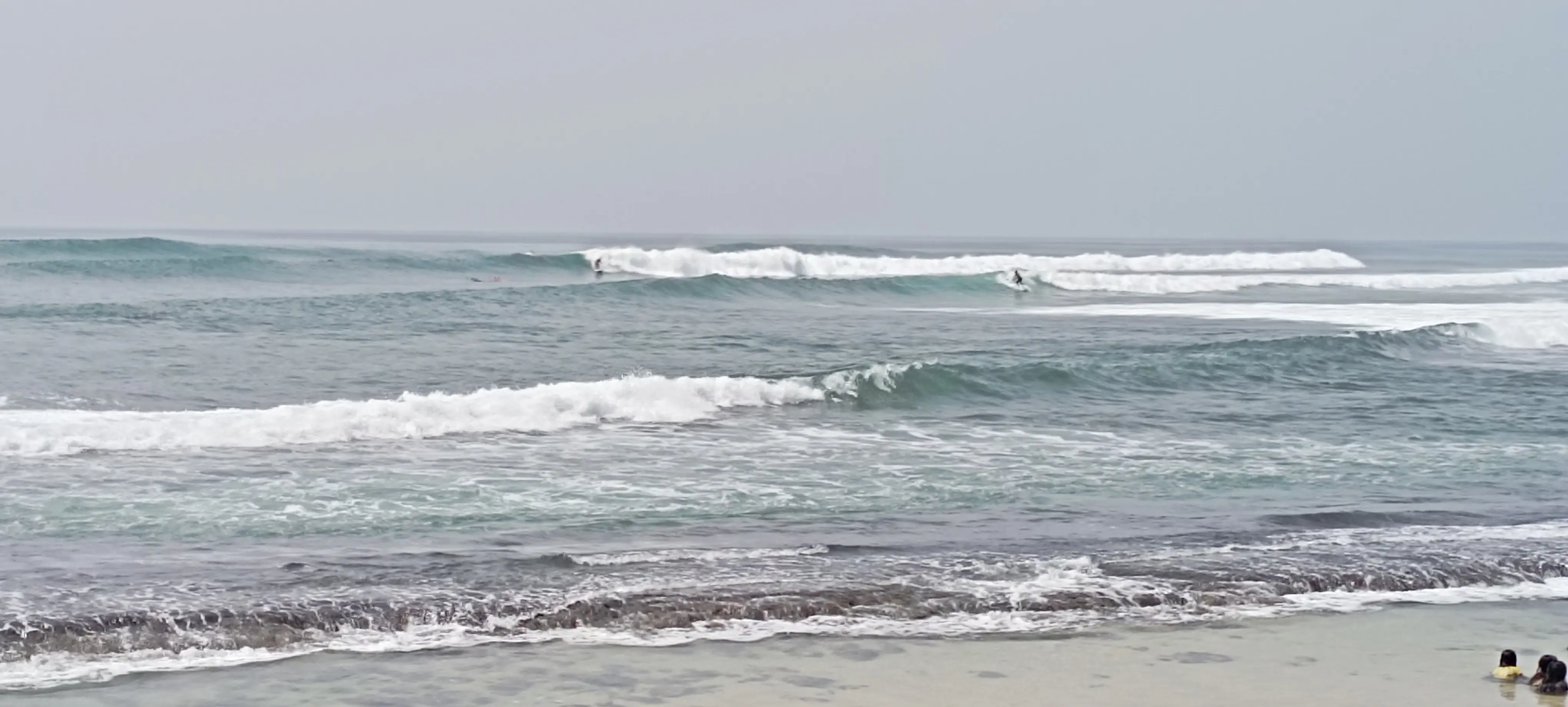
The team’s top picks are:
- Kabalana, an A-frame that can hold some size
- Coconut Tree Hill, a spot found just in front of Sri Lanka’s most photographed location. Be careful; the entry and exit are a little sketchy if you paddle in from the nearby beach
- Madiha, which is in fact two distinct spots. A long peeling right and a powerful left
Tips for a surfing trip On Sri Lanka’s East coast
What you need to know before going surfing in Sri Lanka’s southeast.
generalities
weather and surf forecasting in the east
In Eastern Sri Lanka, the surfing season runs from May to October, bringing warm air and intense sun. Rain is rare, creating an arid landscape that can resemble a desert. With temperatures often exceeding 35°C (95°F) and water temperatures staying around 29°C, you won’t experience a chill in this region. Remember to pack light clothing and ample sunscreen.
Like for the West coast to obtain an easy and accurate surf forecast for the next three days on this coast of Sri Lanka, we recommend visiting Windguru.
Waves Of South East of Ceylon
The east coast of Sri Lanka is renowned for its long right-hand point breaks located around the village of Arugam Bay, making it a true haven for regular surfers. You’ll find these waves to be mellower compared to the barreling reef breaks in Indonesia, but they can still pack a punch while remaining relatively easy to ride. This makes it an excellent destination for intermediate surfers or advanced surfers seeking a laid-back surf trip.
Wave consistency is very high in this region, allowing for surfing opportunities almost every day during the surf season. If you’re lucky, you might even witness larger swells that grace the point breaks, producing incredible, super-long waves thanks to their ability to hold the swell effectively.
One notable feature of this area is the constant side shore wind, which tends to persist throughout the day. However, don’t worry; this doesn’t necessarily mean you’ll encounter choppy surf throughout your trip. Many of the surf spots in the region are strategically located behind rocks, providing shelter from the wind. Unless you specifically seek out certain spots, you should have no trouble finding clean surf at any time of the day.
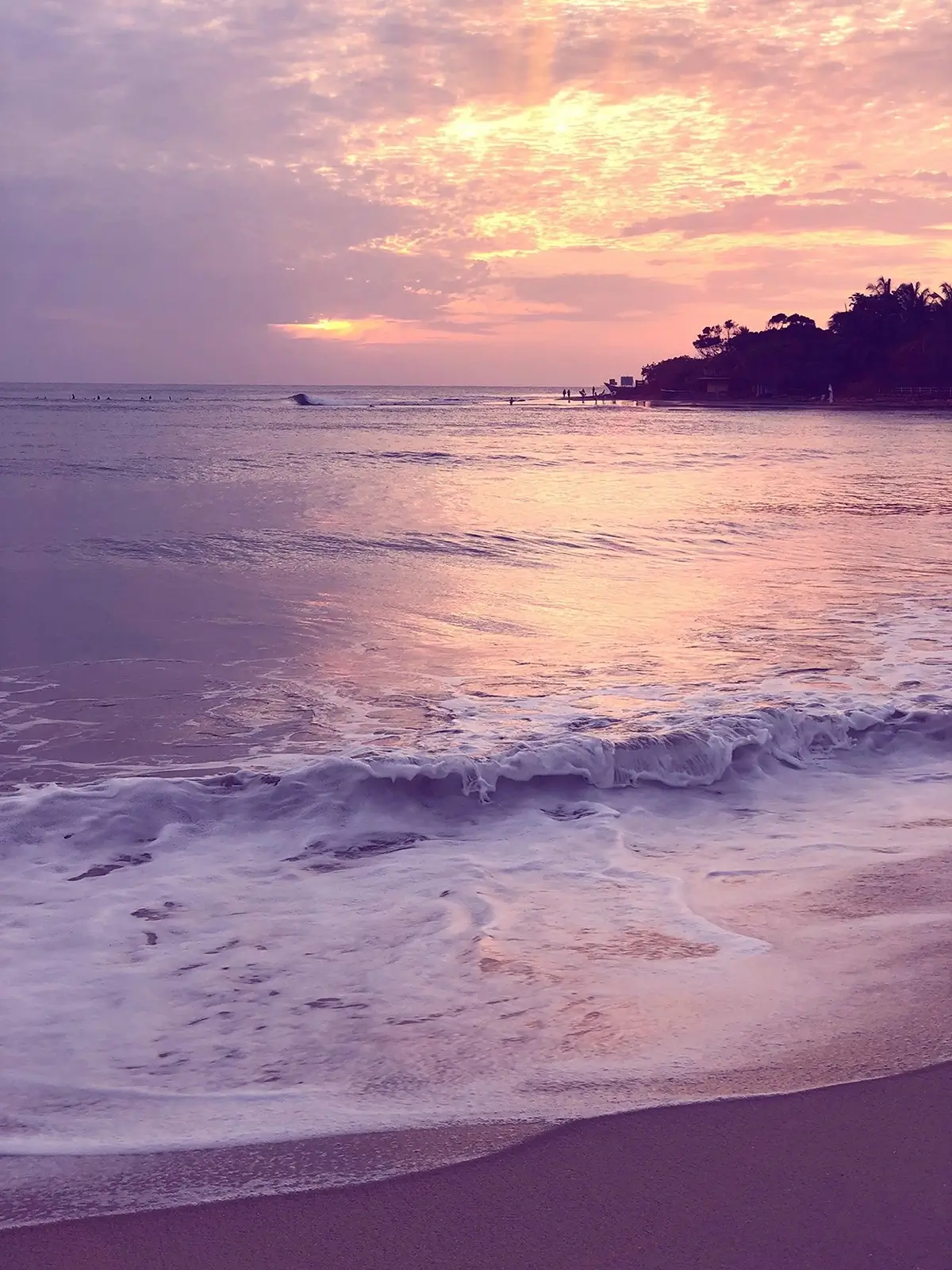
How to get there
There are several transportation options to reach the southeast of Sri Lanka. If you’re traveling from Colombo to Arugam Bay, you will most likely choose between a taxi, bus, or a self-driving vehicle. It’s important to note that, unlike the other surfing coast of Sri Lanka, this side of the country is not well-served by trains and is much farther from the main airport. Arugam Bay is in fact a remote village at the end of the road that follows the east coast as Yala national park south of the village acts as a natural barrier. It will take you at least 6 hours to reach Pottuvil, the small city near Arugam Bay, from Bandaranaike International Airport.
By renting a car / taking a taxi
If you’re traveling with a longboard, SUP, or a large board bag, we recommend considering taxi services or even car rentals. You can easily rent a car or hire a taxi directly from the airport, although it’s worth noting that the most budget-friendly car rental options can be found outside the airport premises. A quick online search will lead you to several automobile rental services, and negotiating a deal can significantly lower the online prices. Keep in mind that many surf spots in the area are situated at the end of small sandy trails within limited space, so a brand-new city car may not be the most practical option for navigating between spots efficiently.
Choosing to take a taxi can be a very convenient option, you can even save money by sharing the cost with fellow travelers. There are numerous active online Facebook groups dedicated to coordinating shared taxi rides. For better rates, we suggest hailing a taxi outside the airport (a short 100-meter walk). To avoid any tourist surcharges, you can also opt for the local app called “Pick Me,” which operates similarly to Uber. However, it’s worth noting that finding a driver willing to provide a 6-hour journey to Arugam Bay through the app might be a bit challenging.
By public transportation
If you plan to travel to the southeast region of Sri Lanka, including destinations like Pottuvil, Arugam Bay, Panama, and others, using public transportation is after taxis the most common option used. To reach this area, you’ll need to first travel to Colombo.
From the airport to Colombo
The direct bus service between the airport and Colombo has been discontinued, and there is no clear timeline for its resumption. However, there are alternative options available to travel to the city.
The journey from the airport to the city center typically takes a little over an hour. You should not encounter any major issues when bringing a reasonably-sized surf bag on these modes of transportation.
From Colombo to the southeast
To travel to the southeast of Sri Lanka by bus, you can catch a bus at Pettah Bus Station (near Colombo Fort) or Colombo Central Bus Stand. It’s important to note that the direct bus route to the southeast is primarily available during the night due to traffic conditions. Several buses, including “luxury AC” and non-AC public buses (often identified by their red color), operate the journey overnight.
If you prefer to travel during the day, you will need to make a stop in Batticaloa, Monaragala, Akkaraipattu, or any other location closer to the east coast. Inquire at the information booth for the available options, as online booking is not available, and schedules and route availability can change. You should also kindly inform the bus driver about your destination so they will let you know when it’s time to disembark.
Please be aware that traveling by public bus to Arugam Bay in Sri Lanka can be a crowded and uncomfortable experience, lasting at least seven hours. However, it can also be a unique and enjoyable way to explore the country and interact with locals, all while enjoying the driver’s favorite Hindi music.
The “luxury buses” offers a different experience, as they provide much more comfort, calm and amenities like phone chargers and Wi-Fi.
The ticket cost varies depending on your destination and is typically paid during the journey. If you’re traveling with a small board bag on the direct route from Colombo to Pottuvil, it can usually be placed in the bus trunk. Otherwise, a second ticket may be required to accommodate it near you. Similarly, “luxury buses with AC” may charge a small fee to store larger bags in the bus trunk. For all of them keep in mind that the buses may not stop directly in Arugam Bay but in nearby cities like Pottuvil or Panama, which are just a few minutes away by tuk-tuk.
How to reach the surf And move around
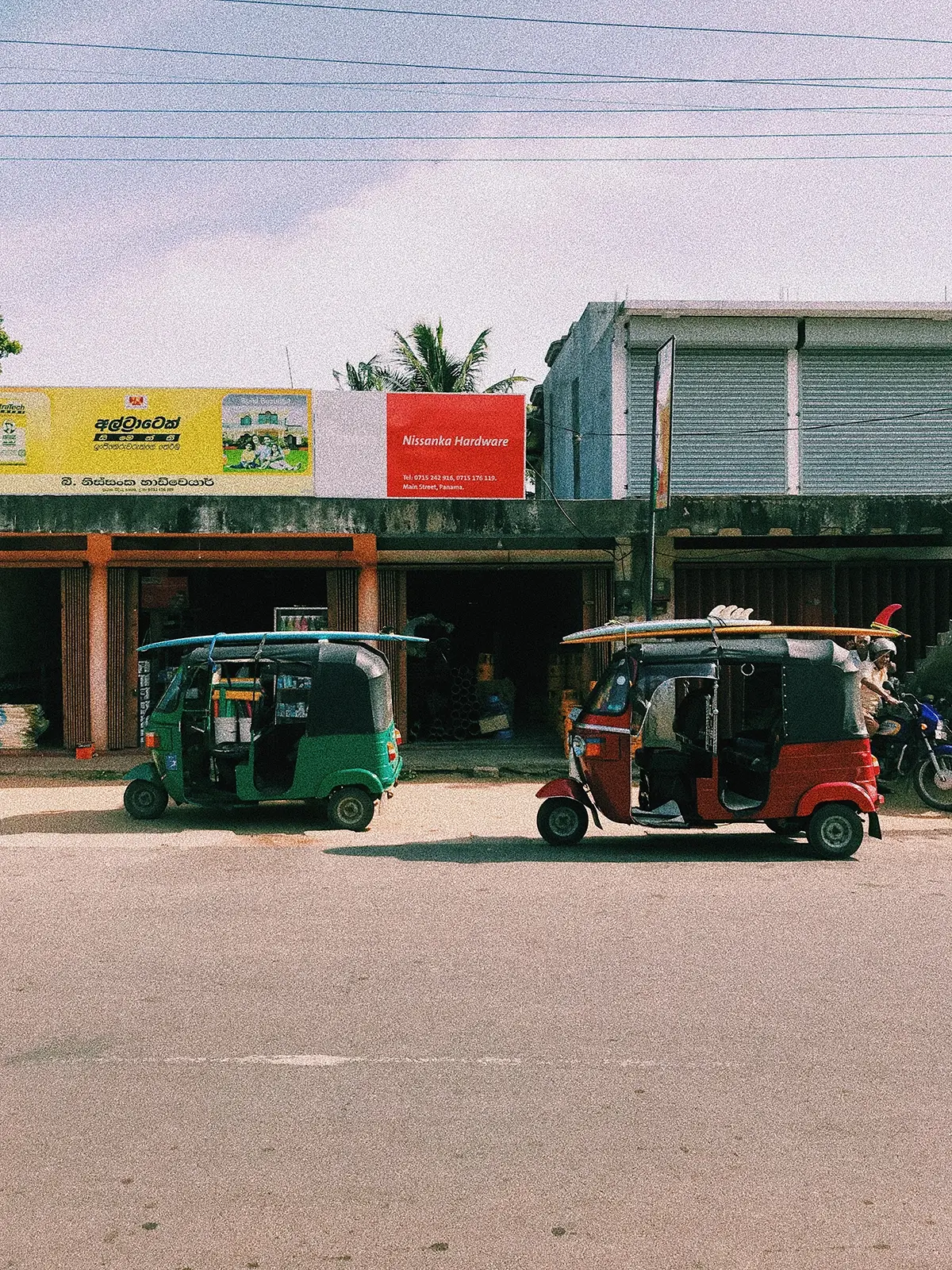
As we said earlier, most of the surf in the area is concentrated around Arugam Bay, a small village located at the southern end of the coastal road. The public bus route runs along the main road near the coast, but unfortunately, it’s not convenient for surfers carrying their boards. Buses do not really stop to let passengers in and off, making it difficult to disembark and get in quickly, especially with surfboards in tow.
As a result, most surfers opt for Tuk Tuk taxis to reach the surf spots. Tuk Tuks are equipped with roof straps to securely transport surfboards, and the drivers are familiar with the locations of the various surf spots in the area.
Alternatively, you can consider renting your own Tuk Tuk and driving yourself along the beautiful roads. To legally drive a Tuk Tuk in Sri Lanka, know that you’ll need to obtain a temporary license from the Automobile Association of Ceylon in Colombo.
Another option, although less common in the area, is to rent a scooter or moped. It’s important to note that scooter surf racks are prohibited and not available in Arugam Bay. However, there are alternative ways to transport your surfboard:
- Place your surfboard in a bag and wear the strap across your shoulder/neck while driving the scooter at a safe speed (Pro Tip: protect the scooter from scratches by putting tape on it)
- Create a DIY soft rack using bungee cords purchased from nearby stores, attaching them to the front plate and back of your scooter
To drive both a Tuk-Tuk or a scooter in Sri Lanka, you must have an international driver’s license. Keep in mind that driving practices may differ from Western countries, with optional signals and priority given to larger vehicles. Stay cautious and anticipate situations on the road even on the rather calm road of the southeast, and if you feel uncertain, it’s best to avoid taking risks.
Surfing Equipment In A-bay
In the southeastern part of Sri Lanka, rental options for surfing equipment are quite limited, and it’s near impossible to find new board shapes available to your size. As most of the rentals are done with old surfboards beaten to death. Therefore, we strongly recommend bringing your own equipment unless you’re planning to stay for a short period or take a few surf lessons. It’s important to note that purchasing complete surfing equipment, from boards to wax, can be expensive and of low quality in Sri Lanka and particularly in the remote Arugam Bay. To ensure you have what you need, consider bringing your own gear in double. If you require additional accessories like leashes, fins, or traction pads, we have a great selection available for worldwide delivery, including shipping to Sri Lanka.
the surf breaks on the East Side of the island
The surf breaks on the east side of the island are primarily located along a 20-kilometer stretch of the same road. This area is between the town of Pottuvil and the small township of Panama, with Arugam Bay conveniently situated in the center, offering most of the tourist amenities.
Although we won’t delve into specific details about every surfing spot near Arugam Bay, we have made an effort to compile the majority of them in an interactive Google Maps.
East Sri Lanka surf spot map:Each blue point on the map represents a different spot. The prevailing swell originates from the southeast, while the primary wind direction is from the south
The most renowned surf spot on Sri Lanka’s east coast is Main Point, situated in Arugam Bay. As the name implies, it is the spot that brought fame to this location. Main Point features a long and powerful right point break, which, on good days, can even produce barrels in its upper section—a rather rare occurrence for the area. One notable characteristic of this break is its exposure to the wind, making it ideal to surf early in the morning or late in the afternoon. This same wave break extends further down the beach and creates a second, more sheltered point break known as Baby Point, which is perfect for beginners.
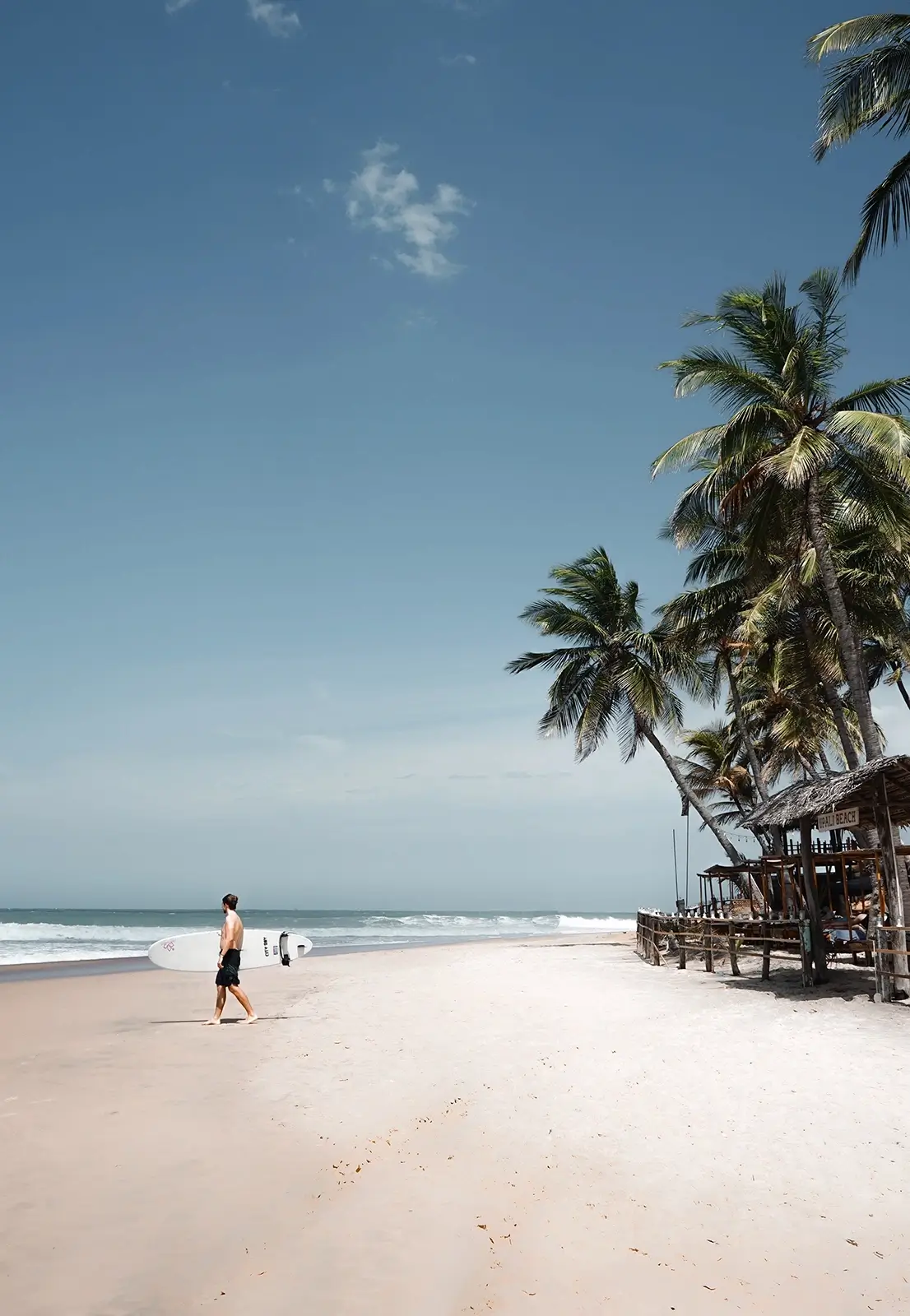
Our team’s favorite spots are:
- Pottuvil Point, located just a few kilometers north of the town, it offers one of the world’s longest waves during big swells. It features a punchy section right in the middle, and if you happen to leave the water at dawn, you might even see elephants near the nearby lake
- Peanuts Farm, this spot may be slightly shorter compared to other long waves in the area, but it packs more power and intensity
If you have any questions, let us know in a comment!
If you need any surfing equipment, have a look at our performant and accessible Fins , Traction Pads, and Leashes, we deliver worldwide!
Enjoy your time in Sri Lanka; it’s a wonderful place!

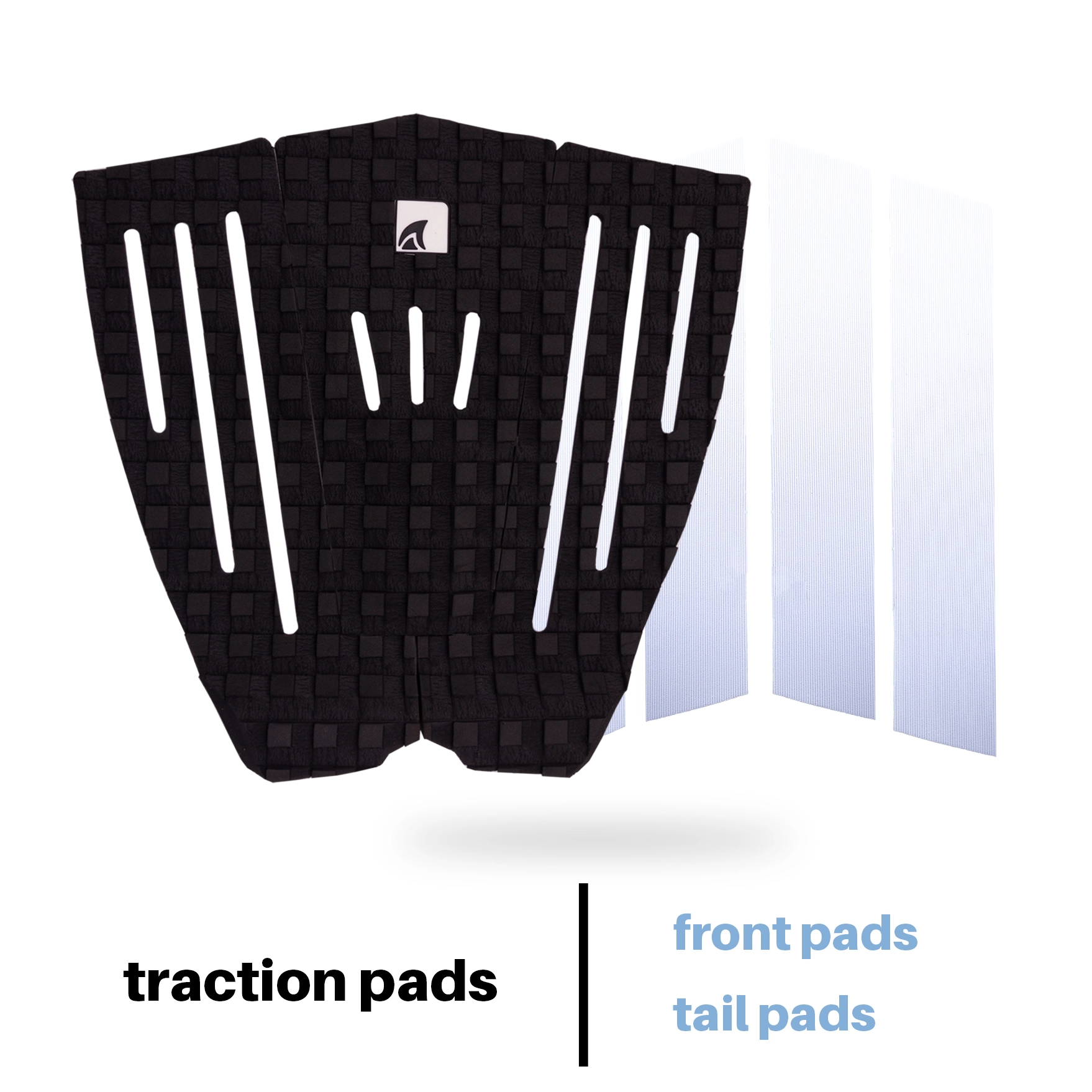


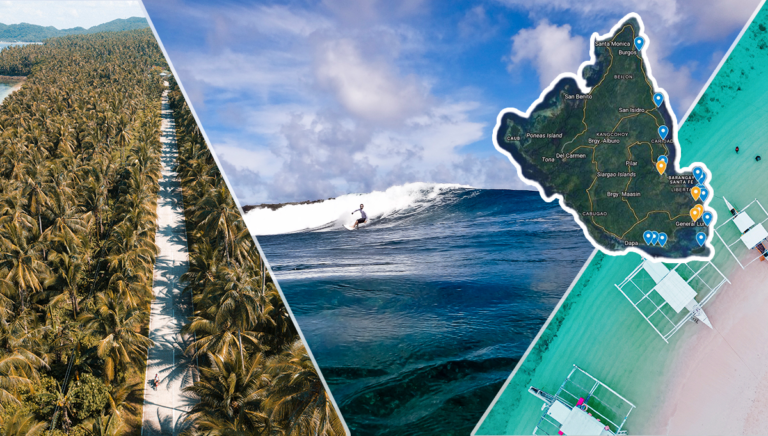
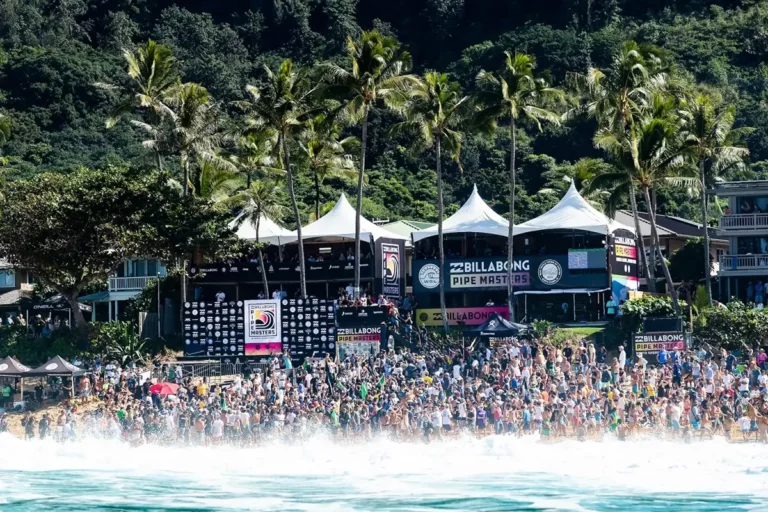
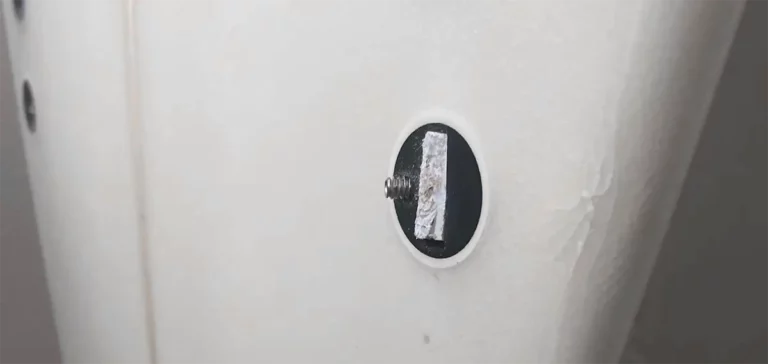
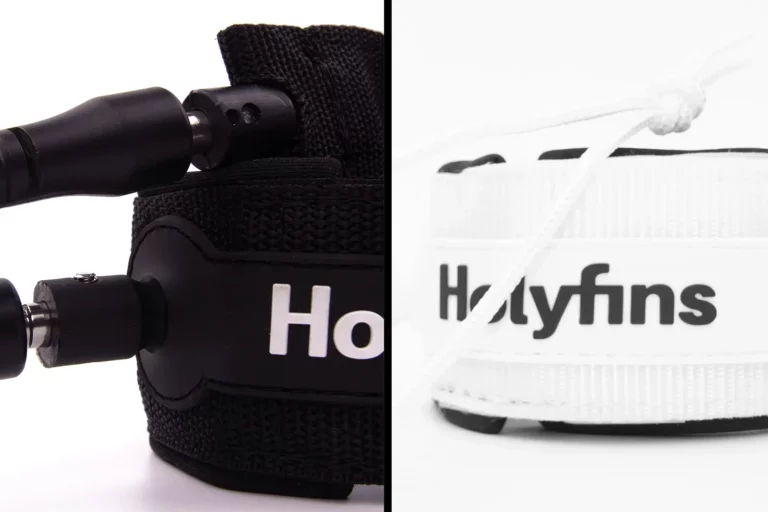

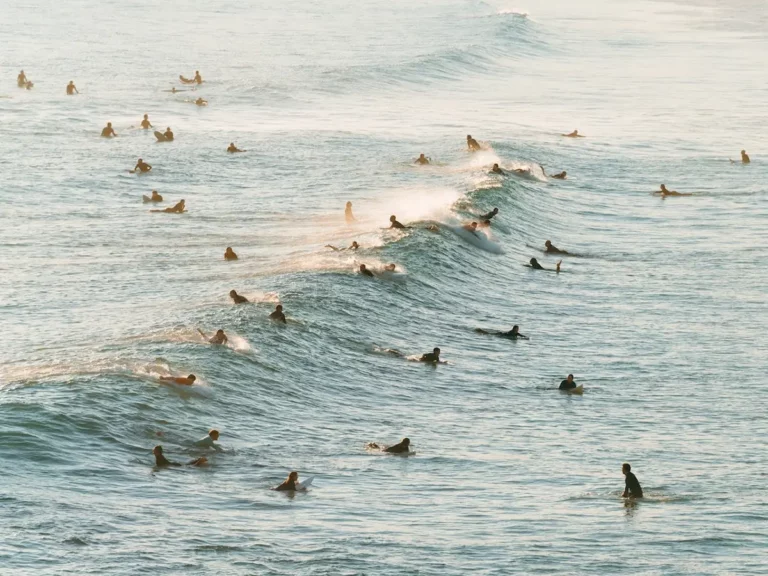
Leave a Reply